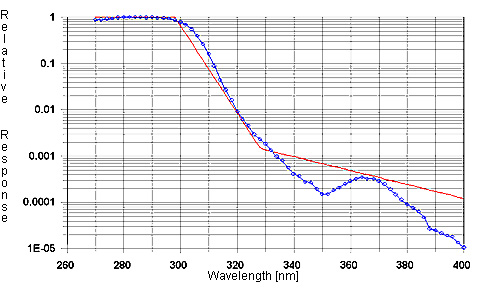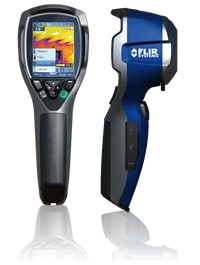|
Designed specifically for testing of sun beds and the W/m2 Eeff (Ery) limits set out in the new EU regulations of a maximun of 0.3 W/m2.

 Integral Sensor Integral Sensor
 Compact Compact
 Durable Durable
 Accurate Accurate
 LCD readout LCD readout

 W/m2 Ery Lamp/Sun Output W/m2 Ery Lamp/Sun Output
 Check EU 0.3 W/m2 Maximum Check EU 0.3 W/m2 Maximum
 Acrylic Shield Transmission Acrylic Shield Transmission
 Eyewear UV block comparison Eyewear UV block comparison
Sensor/Detector
Silicon Carbide (SIC) Photodiode packaged in hermetically sealed UV glass window cap.
Interference filter coating (Metal Oxide) blocks UV above erythermal response as show on Spectral Sensitivity Graph.
Operation
Press and hold push-button switch on face of unit. Aim sensor window in top panel of meter directly at UV source. For tanning beds place meter at body position. Note reading on LCD and record if desired.
Battery operation voltage is 9V down to 6.5V. Below 6.5V the LCD numbers will begin to dim, indicating the need for battery replacement. Under "typical" service load, the battery should last about 2 years.

Detector Data
|
| Model |
7.5 |
| Irrad. Range |
19.99 W/m² ERY |
| Response |
280-400 nm Diffey Erythermal Action Spectrum |
| Resolution |
0.01 W/m² |
| Conversion Rate |
3.0 Readings/Sec |
| Lens |
UV Glass |
| Diffuser |
Virgin Teflon .005" |
| Accuracy |
±10% REF NIST |
| Display |
| Type |
3.5 Digit LCD |
| Digit Size |
10mm |
| Environmental data |
| Operating temperature range |
+0°C to +32°C |
| Operating Humidity |
5% to 80% RH |
| Physical characteristics |
| Size, L x W x H |
105 x 6- x 20mm |
| Weight |
110g |
| Power Source |
| Battery |
9V PP3 Battery |

Proper Usage of Solarmeter ® Ultraviolet Radiometer for Lamp Aging Tests
 Wear eye protection when checking UV lamps (UV-block wrap around glasses). Wear eye protection when checking UV lamps (UV-block wrap around glasses).
 Allow lamps to warm-up prior to taking readings (at least 5 min). Allow lamps to warm-up prior to taking readings (at least 5 min).
 When checking aging of lamps, keep measuring distance and locations constant. When checking aging of lamps, keep measuring distance and locations constant.
 Lamps should be replaced when output drops 30% to about 70% of their original (new) readings. Take overall reading at exposure distance, or check individual lamps close to surface. Keep track of hours vs. readings on a chart. Lamps should be replaced when output drops 30% to about 70% of their original (new) readings. Take overall reading at exposure distance, or check individual lamps close to surface. Keep track of hours vs. readings on a chart.
 If unsure of what original new values were, replace lamp(s) with new ones of the same kind and compare to old ones. If unsure of what original new values were, replace lamp(s) with new ones of the same kind and compare to old ones.
 To determine percent UVB divide Model 6.2 reading by Model 5.7 total UV (UVA + B) reading. To determine percent UVB divide Model 6.2 reading by Model 5.7 total UV (UVA + B) reading.
 When checking UVT acrylic transmission, take reading through acrylic; then remove acrylic and hold meter sensor at approximately the same distance from lamp as the acrylic shield was located. If acrylic blocks much UVB it should be replaced. When checking UVT acrylic transmission, take reading through acrylic; then remove acrylic and hold meter sensor at approximately the same distance from lamp as the acrylic shield was located. If acrylic blocks much UVB it should be replaced.
 When using this meter to compare different type lamps, due to their different spectral power distributions, the readings should be considered relative rather than absolute. Although higher output lamps of similar SPD's will generally read higher than lower output lamps, ones that peak near 290-300 nm (as does the meter response) will read higher than ones peaking near 313 nm even if the total UVB output of both is the same. When using this meter to compare different type lamps, due to their different spectral power distributions, the readings should be considered relative rather than absolute. Although higher output lamps of similar SPD's will generally read higher than lower output lamps, ones that peak near 290-300 nm (as does the meter response) will read higher than ones peaking near 313 nm even if the total UVB output of both is the same.
 Do not subject the meter to extremes in temperature, humidity, shock or dust. Do not subject the meter to extremes in temperature, humidity, shock or dust.
 Use a dry, soft cloth to clean the intrument. Keep sensor free of oil, dirt, etc. Use a dry, soft cloth to clean the intrument. Keep sensor free of oil, dirt, etc.

 1no: Solarmeter® 7.5 UV Meter 1no: Solarmeter® 7.5 UV Meter
 1no: Manufacturers Calibration Certificate 1no: Manufacturers Calibration Certificate
 1no: Leather Protective CaseBattery(2 x AAA) 1no: Leather Protective CaseBattery(2 x AAA)
 1no: 9V PP3 Battery 1no: 9V PP3 Battery
 1no: Instruction Sheet 1no: Instruction Sheet
 1no: 12 Month Warranty 1no: 12 Month Warranty
|

















